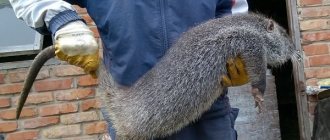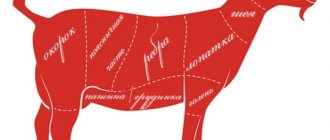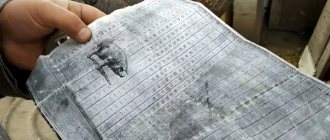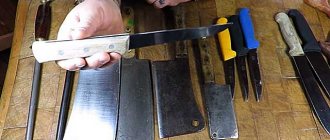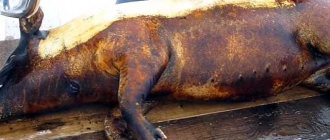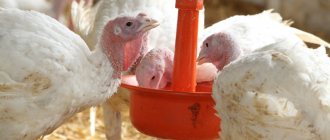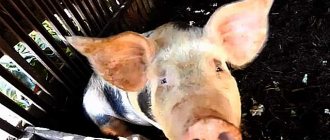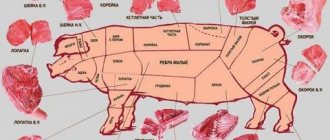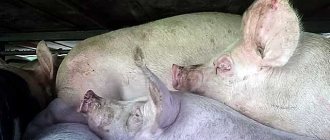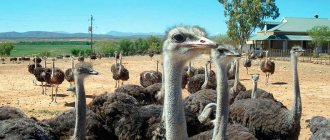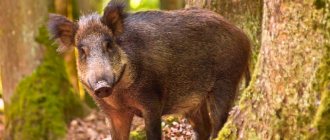Pig slaughter is the most unpleasant stage of raising a Vietnamese pig for a pig farmer, but it still cannot be done without it. You have two ways - contact professional slaughterers or learn the basics of doing the work yourself. It is recommended to carry out slaughtering for the first time under the supervision of an experienced butcher, who will provide insurance and give useful recommendations. Before him, it is advisable to attend the slaughter at least once - this way it will be easier for you to understand what’s what than just using methodological recommendations and videos. The main requirement for the correct execution of work is that everything must be done quickly, so that the animal does not have time to become very frightened.
Maximum weight and volume of piglets and adult Vietnamese pot-bellied pigs for slaughter
Before slaughter, the weight should be between 110 and 112 kg, it is not worth raising more than that, as it will become fat. Age in this case is not so important - they focus on weight.
On average, animals reach the weight required for slaughter within six months of breeding, provided proper feeding.
Since it is difficult to weigh a pig, we recommend that you focus on its parameters - namely chest girth and body length. First, the length of the body is measured - the tape is applied to the middle of the back of the head, then stretched along the neck, withers, and back in a straight line. You will need to reach the root of the tail. In this case, the pig should stand with a level (that is, horizontally positioned) head.
Measuring is much more convenient than weighing.
How many kg of meat are in a Vietnamese pig?
The meat yield should not be less than 40 kg. Usually this weight is declared at 7 months of age. It is stated that the most rapid weight gain occurs at the age of 5-7 months.
Interesting materials:
How long does it take for linoleum glue to dry? How long does it take for water-based stain to dry? How much salt and soda should I add to the bath? How much salt to put in dry-cured sausage? How much salt is there in the Caspian Sea? How long do bears sleep at night? How long do hibernating snails sleep? How much alcohol is in greenery? How long does a kitten sleep at 2 weeks? How many athletes participate in the mass start?
Slaughter at home
Slaughter can begin only when the animal is ready for it. The time of year can be any - the main thing is that the pig has time to gain the required weight. This article will tell you about fattening piglets for meat at home. Let's consider the main methods of carrying out work.
How to stab in the heart
A simple and effective method that is most often used by experienced carvers. The animal is secured with ropes by its front and hind legs. It is advisable that 2-3 people hold it - this way everything can be done as quickly as possible. Two people must hold the pig during slaughter, and the third one makes the puncture.
It is not advisable to pierce alone. At least two people are needed to hold the animal.
The restrained animal is placed on its right side, and then a long thin knife is thrust directly into the heart (in a pig it is located in the same place as in a person - between the fourth and third ribs). You should not immediately take out the knife - wait until the animal calms down, and only then remove it from the wound. Support the blade with a clean, thick piece of cloth.
The length of the knife blade should be at least 30 cm - you simply won’t kill a pig with a shorter one.
Puncture in the neck
A couple of people will be enough - one stabs the neck, and the second holds the animal by the legs . First, the pig will need to be placed on the slaughter table with the legs pointing up. Direct the animal's head so that it is comfortable for you (right-handed to the right, left-handed to the left). Pigs weighing at least 100 kg are used for slaughter.
Place a basin near the table - the blood will subside into it. The puncture is made 2-3 cm from the ear.
As soon as you give the injection, the animal will go into shock. Then lay him on his side and press him to the table by his right leg. The blood begins to flow immediately, the pig quickly calms down and falls asleep. A puncture in the neck is the best way to slaughter small breeds like Vietnamese.
How to score using a stun gun
The most inhumane method of slaughter, but it is sometimes used for wild boars. The fact is that males are quite strong, and even strong men cannot always hold them. If the fight is a single one, you simply have no chance - so first stun the animal with a stun gun, and then cut its artery or pierce its heart. Thanks to a stun gun, you can handle slaughter alone.
Firearms
The most inhumane and impractical way. It is quite difficult to hit a pig that has sensed danger with a gun, and inept attempts and inaccurate hits in the “atmosphere” are unsafe for others. Therefore, the use of this technique is considered a last resort - you should not resort to it unless absolutely necessary. Usually they resort to weapons when the animal has already broken free and started to run away.
My Piglet
Hello, dear Vietnamese pig holder. Depending on the new addition to our family, from time to time we have to kill pigs and boars for meat. We usually adjust to the holidays so that the carcasses are sold more cheerfully. May-lingering ones are no exception. We figured it out, weighed it, sorted it, the pigs were ready for slaughter, off we went.
I think that I will not be discovering America if I say that sooner or later every piglet owner has to face the task of transforming a living, grunting plump piglet into juicy cutlets. Hence the question. What technology for slaughtering pigs is the most acceptable and least labor-intensive, which will cause the least amount of pain?
Having rummaged through the network, I discovered many methods and entire techniques, both effective and, in my opinion, sadistic. They hit you in the heart, throat, stun with electric shock, shocker; they shoot from various types of weapons, without fear of ricochets and with pleasure, they tell how in a neighboring chicken coop, a bullet that has changed its trajectory catches up with an unsuspecting rooster. Well, let's leave the step-by-step slaughter of pigs to the imagination of the killers. In this article I would like to talk about my experience and some results. So, let's begin.
For sale as meat, we select piglets aged 4-6 months. There is no point in keeping it any longer; I know pig farmers who slaughter pigs at the age of three months - just to go. Depending on the orders, we select the pig by weight. We slaughter pigs together, it’s more convenient. Although 35-40 kilograms is possible alone, but let it be as best as possible. And it’s calmer that there will be no unnecessary movements. The process itself takes about two minutes, I hit the neck, about two or three fingers from the ear, in nine cases out of ten, I hit the artery straight away - that’s it. The boletus (pig) switches off almost immediately, there is a minimum of suffering and no adventures.
The first part, in my opinion, is the simplest. Then begins the more labor-intensive stage of processing the carcass. Question again. How to cut up a carcass? Let's move on. Before cutting, it is necessary to thoroughly singe and clean all parts of the carcass. Here I want to go into more detail. The generally accepted method of processing is to remove the bristles and remove the top layer of skin. I fully adhere to traditional methods, processing with a blowtorch and a propane torch. The process is long, but with some dexterity and skill, it becomes faster. I no longer notice how and what, my hands do it themselves.
Next, blackening. For sale, sometimes you have to ink a little less, this is not good. I try to talk to the buyer in advance and almost always get the go-ahead to blacken as much as possible, although there is a risk of cracks in the skin (a decrease in presentation, but also an increase in the taste of the skin).
The final stage. We cover the entire household with a damp cloth for a few minutes and pour hot water on top; our boiler is set to heat the water to 55 degrees - quite hot water. When the pig carcass has thoroughly soaked and the blackened layer begins to smudge if you rub it with your hand, I begin to scrape and wash. Now attention. On May Day, I killed a boletus and decided to deviate from the traditional scraping and used a high-pressure washer - a Karcher. I was very pleased with the result and now, in the warm season, I will use this method.
I'll start with the positives:
— The time needed to wash mascara has been halved. - The most difficult, terrible places are washed perfectly. Now you don’t have to, with a small knife, suffer with hooves and a head with multiple folds. — Contrary to my experiences, the surface after washing with a Karcher remained as smooth as after scraping. Really can't tell the difference. - Well, I’ll add a sanitary unit. There are no residues, scraps, any dirt, etc. left on the table or on the carcass. Everything is washed to a shine. Pure pleasure.
A couple of disadvantages:
— Karcher cannot remove some firing residues. In my case, I have to refine it with a knife on the back, although only a little (if you burn it, you won’t be able to scrape it off with a knife either). — When scraping, a layer of skin is still removed, albeit an insignificant one, making it thinner. Although a four-month-old boar of the Vietnamese pot-bellied breed already has a skin that falls off from the fat and is super soft in itself. Literally briefly further cutting: I put the carcass on its back (legs up), separate the head, make a cut from the neck to the tail along the chest and belly. With my right hand I hold the esophagus, with my left I help separate the insides from the chest. So I pull everything out at once into a nearby dish and get a clean carcass, which I pour again from the Karcher until shiny, divide lengthwise into two halves and hang each half by its hind legs in a secluded cool room to cool. The liver and liver are also taken away from the entrails. Then we take out the intestines, wash them and use them for sausage. Yummy!
Best regards, Megasergei.
Features of slaughter: age, weight, how to cut
The specifics of slaughter depend on the weight of the animal. You can cut a suckling pig alone, you only need a high stool. To make the procedure painless, wait until the animal falls asleep . Larger pigs need to be restrained, so enlist the help of at least one other person. The animal stops bleeding approximately six minutes after slaughter.
If you know for sure that you will not be able to hold the boar, first immobilize it with a shocker.
A large boar is slaughtered by a team, since the animal has impressive weight and considerable strength. For a 120 kg boar you need at least three people - one will lure the animal, and two will tie it up. After using any slaughter method of your choice, the blood must be drained - otherwise the lard will turn out red and the taste of the meat will change.
What to feed pigs in winter
In the process of fattening Vietnamese pigs, a novice farmer may have a question: how to properly feed piglets during the cold season. In winter, the number of feedings increases from two to three. The grass is replaced with dry tops and hay. Since grains contain little protein, animals need to be supplemented with oil cake, legumes, yeast, fishmeal and skim milk. 20% of the total diet should be grains and acorns. In the cold season, you need to increase the amount of feed and make mash with bran.
How to butcher a pig carcass
When a pig is slaughtered, the carcass must be properly dressed. The main task of performing the work is to properly separate the meat and lard so as not to damage the internal organs. Take special care with the urinary and gall bladders - if you pierce them, you will spoil the raw meat.
The procedure for performing cutting work:
- The head is cut off.
- An “apron” is carefully cut out on the peritoneum.
- The head is cut into two parts (in the center).
- The end of the esophagus is tied, after which it is removed from the carcass.
- The lungs, diaphragm, and heart are removed.
- The intestines are carefully removed, then the stomach.
- Cut off the liver, cut off the gall and throw it away.
- Remove all internal fat.
- Cut off the kidneys and bladder, the bladder will also need to be thrown away.
The diagram for cutting up a pig carcass can be found here.
Section layout.
That's all - all that remains is to wipe the carcass with napkins or rags and divide it into two parts.
You should not wash the inside of a cut pork carcass - this will cause the meat to quickly deteriorate.
If you learn how to slaughter pigs yourself, you will save a lot of money on their slaughter. Do not get attached to animals, do not give them nicknames and remember that the main task of wild boars is to go to slaughter. This will help overcome the psychological barrier. Read about the large white breed of pigs at this link.
Bleeding
The presence of blood in meat deteriorates its quality, so when slaughtering a pig, care must be taken to quickly bleed the carcass. As mentioned above, the ideal option is to open the carotid artery and jugular vein. Then almost all the blood will flow out of the animal itself.
If a pig has been killed by a blow to the heart, some blood will certainly collect in its chest cavity. When opening the animal, the collected liquid can be scooped out with any convenient container, and the resulting clots can be removed with a napkin or clean rag.
What a beginner needs to know to cut correctly
Useful tips for slaughtering pigs for a beginner:
- Immediately prepare a container where and into which you will drain the blood - otherwise you risk delaying, and the meat and lard will be spoiled.
- Look for an assistant - it will be difficult to kill the animal alone.
- Use for slaughter (to kill) a place that will be easy to clean after finishing the work (to score, to burn).
- There is no need to feed the animal before slaughter in order to quickly lure it with food immediately before day X.
- If possible, wash the pig at full length (completely) - this will make cutting it both easier and more enjoyable.
- Behave as calmly, peacefully and confidently as possible , do not shout at the pig, do not push him, as this will only increase the stress level.
You can find out more about meat and fat breeds of pigs here.
In order not to encounter a psychological barrier when slaughtering wild boars, give yourself the initial setting - the animal is raised (you kept and raised / the pig grew up) for slaughter.
Preparation for slaughter
In order for a farmer to be able to legally sell meat, the animal must be examined by a veterinarian before slaughter. After the examination, the doctor issues an appropriate certificate containing information about the age of the individual, the date of its slaughter and the region of origin, confirming that it is free from the main highly contagious diseases. It also makes sense to consult with a veterinarian about further examinations that will need to be carried out on meat products before sale.
To properly slaughter a pig, you will need a certain set of special tools and some devices :
- a concrete platform or wooden pallet where it will be convenient to carry out cutting work;
- a long, rigid knife with a well-sharpened edge;
- strong ropes;
- blood collection container;
- clean napkins or gauze rags;
- blowtorch or gas torch for burning the carcass.
Preparatory procedures for slaughter also apply to the pig itself. In the last 12 hours of her life, she is not fed, given only clean water, so that the intestines are completely cleansed. It is also easier to lure a hungry pig out; it will be more willing to leave its home if you lure it with food.
When the pig goes outside, you can try to cover its head with some kind of container, such as a basin or large pan. However, sudden movements should be avoided so as not to frighten the animal ahead of time (otherwise the taste of the meat may deteriorate). If the pig was kept in a small room, then most likely there will be dirt on its skin, which must be washed with warm water using a brush or broom.
Arrangement of the slaughter area
It is important to prepare the slaughter area, which should be at the maximum possible distance from the pigsty and not visible to other fattened animals.
You must first prepare containers for collecting blood, as well as hot water, which will be used to wash the slaughterer’s hands and the carcass itself.
In industrial pig farming, special hangers for carcasses are used, which allow better drainage of blood, but for small producers it makes no sense to make such structures on purpose.
The owner of a pig farm can slaughter a small Vietnamese pot-bellied pig himself, but an assistant will be needed to slaughter a large animal.
conclusions
- Adult Vietnamese pot-bellied pigs are slaughtered at home when they reach a weight of 110-112 kg. Since it is difficult to weigh an animal, special tables are used to determine its weight.
- The main methods of slaughter are stabbing, piercing the heart or neck, using an electric shocker, or using a firearm. The last two are not recommended to be used in excess, since they are the most unsafe.
- You can only cut a suckling pig alone - in other cases, 2-3 people should participate in the process. If the boar is strong and violent, you can first immobilize it with a shocker.
- Blood after a puncture must be drained immediately to avoid spoilage of meat and lard. But it is highly not recommended to rinse the carcass with water after cutting.
Read about breeding Vietnamese pigs in this material.
Cleanse skin of dirt and deposits
After completion of the roasting process, the carcass of the lop-eared pig should acquire a dark golden color, which signals the need for the last stage of stripping the skin.
A pot-bellied pig laid on a wooden shield should be covered with a piece of clean canvas and doused with hot water, the temperature of which is about 60 degrees Celsius.
Within 7-10 minutes the skin will become wet and it will be possible to clean it of carbon deposits and dirt using a knife or a metal brush. Most often, a household dishwashing brush is used for this purpose, which can be purchased at any hardware store.
Cleaning and scraping is carried out until the skin of the Vietnamese pig becomes light and no traces of hair are visible on it. If you plan to sell meat and lard at the market, then you need to re-cover the pig with a piece of cloth or an old blanket, leaving it in that position. After about half an hour, you can start cutting up the carcass.
